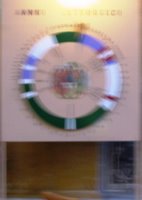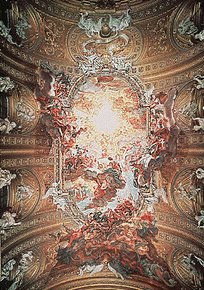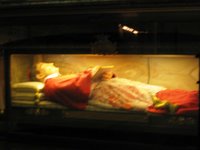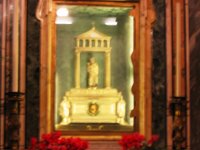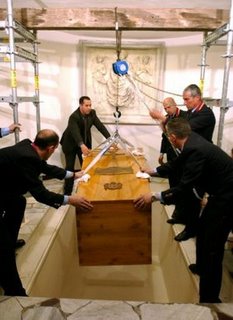From Michael Dubruiel in 2006
I had bought an alarm clock about four days into our trip to insure that I would get up and make it over to St. Peter's in the morning when it opened up. On Saturday morning I was up bright and early and made it over to be one of the first in line. "The line" was for us commoners, there were always people and priests already in St. Peter's that obviously entered from another place, another "gate" if you would.
This morning I headed right for the grottoes as they had become my favorite places to pray the morning office and attend Mass if possible. I passed a number of Masses being said already in several of the chapels, none in English. Then I arrived at the Clementine and there was a small group following me there: several older Italian women, two priest vested in purple and a cardinal. They went into the Clementine Chapel--so I followed them in, when the cardinal turned around to begin the Mass I recognized him right away, it was Cardinal Ruini, the vicar of Rome (in some way the de facto bishop of Rome). I decided to stay. The Mass was said in Italian and I could follow most of it, even make out the Gospel reading and that it was the Feast of St. Casmir (a saintly king of Poland). I was struck by the humility of the cardinal who when he preached kept his eyes closed for almost the entire homily. He mentioned Pope John Paul (I presume in connection with the day's feast). It was a very reverential and spiritual Mass. At the conclusion the cardinal accompanied by the two priests paused and the tomb of Pope Pius XII (in a direct line with the Clementine Chapel and said a short prayer, then they went out the way we had come in, I went in the other direction. When I emerged at the tomb of Pope John Paul II, I found that Cardinal Ruini along with the other two priests were there on their knees. Cardinal Ruini with hand to his eyes seemed be sobbing. They stayed there for some time before getting up and exiting the grottoes. I stood with the group that always seems to be present there,praying the rosary.
This morning the Basilica was even less crowded than usual for this time of the morning and I found that there was no Mass being said at the Chair of Peter, so I settled into one of the pews to pray the office. I think I had reached the First Reading in the Office of Readings when a Basilica aid told me that I couldn't pray there (this is only for Mass). I tried to protest, but he spoke no English and I decided to go to the Blessed Sacrament chapel. On my way I stopped at the tomb of Blessed John XXIII and sat in a pew there. When I finished, since there was no Mass being said I went up and prayed close to the glass tomb and peered in at the face of Blessed John, I was somewhat still marveling at the face of St. Joseph Maria Tomasi who has a visible beard on his face even though he's been lying in rest since 1713. Blessed John had on beard (I guess the pope's have better razors).
Back at the apartment, Amy was waiting on another filming apointment which was suppose to happen at 9:00 a.m this time at our apartment. It was 9:15 when we decided to go (given that we were down to our final two full days in Rome). We had reached the end of the Borgo Pio when the film crew spotted us from the Porta San Ann. They took Amy from us and we resorted to visiting gift shops and then going into the Sant'Anna dei Palafrenieri (said a prayer for my sister Ann)(the link will tell you this church--the parish church of Vatican City isn't open to the public--I went into it at least five times while I was there and it seemed very open to me), just in Vatican City and saying a few prayers. When we came out Amy was heading back to us--we made our way to the tram, and then to the Metro for another heavy day of pilgrimage stops.
I had bought an alarm clock about four days into our trip to insure that I would get up and make it over to St. Peter's in the morning when it opened up. On Saturday morning I was up bright and early and made it over to be one of the first in line. "The line" was for us commoners, there were always people and priests already in St. Peter's that obviously entered from another place, another "gate" if you would.
This morning I headed right for the grottoes as they had become my favorite places to pray the morning office and attend Mass if possible. I passed a number of Masses being said already in several of the chapels, none in English. Then I arrived at the Clementine and there was a small group following me there: several older Italian women, two priest vested in purple and a cardinal. They went into the Clementine Chapel--so I followed them in, when the cardinal turned around to begin the Mass I recognized him right away, it was Cardinal Ruini, the vicar of Rome (in some way the de facto bishop of Rome). I decided to stay. The Mass was said in Italian and I could follow most of it, even make out the Gospel reading and that it was the Feast of St. Casmir (a saintly king of Poland). I was struck by the humility of the cardinal who when he preached kept his eyes closed for almost the entire homily. He mentioned Pope John Paul (I presume in connection with the day's feast). It was a very reverential and spiritual Mass. At the conclusion the cardinal accompanied by the two priests paused and the tomb of Pope Pius XII (in a direct line with the Clementine Chapel and said a short prayer, then they went out the way we had come in, I went in the other direction. When I emerged at the tomb of Pope John Paul II, I found that Cardinal Ruini along with the other two priests were there on their knees. Cardinal Ruini with hand to his eyes seemed be sobbing. They stayed there for some time before getting up and exiting the grottoes. I stood with the group that always seems to be present there,praying the rosary.
This morning the Basilica was even less crowded than usual for this time of the morning and I found that there was no Mass being said at the Chair of Peter, so I settled into one of the pews to pray the office. I think I had reached the First Reading in the Office of Readings when a Basilica aid told me that I couldn't pray there (this is only for Mass). I tried to protest, but he spoke no English and I decided to go to the Blessed Sacrament chapel. On my way I stopped at the tomb of Blessed John XXIII and sat in a pew there. When I finished, since there was no Mass being said I went up and prayed close to the glass tomb and peered in at the face of Blessed John, I was somewhat still marveling at the face of St. Joseph Maria Tomasi who has a visible beard on his face even though he's been lying in rest since 1713. Blessed John had on beard (I guess the pope's have better razors).
Back at the apartment, Amy was waiting on another filming apointment which was suppose to happen at 9:00 a.m this time at our apartment. It was 9:15 when we decided to go (given that we were down to our final two full days in Rome). We had reached the end of the Borgo Pio when the film crew spotted us from the Porta San Ann. They took Amy from us and we resorted to visiting gift shops and then going into the Sant'Anna dei Palafrenieri (said a prayer for my sister Ann)(the link will tell you this church--the parish church of Vatican City isn't open to the public--I went into it at least five times while I was there and it seemed very open to me), just in Vatican City and saying a few prayers. When we came out Amy was heading back to us--we made our way to the tram, and then to the Metro for another heavy day of pilgrimage stops.
